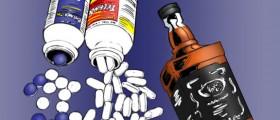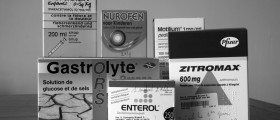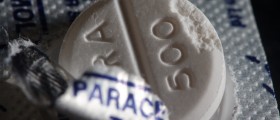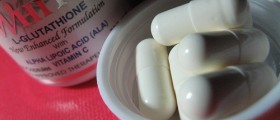
What is N-acetylcysteine?
N-acetylcysteine is a substance obtained from L-cysteine, a sulfur-containing amino acid. Amino acids are the basic components of every single protein in the human body.
The substance itself is a very powerful tool used by medical experts. It is proven to be highly efficient against certain health problems. For, instance the foremost role of N-acetylcysteine is to fight acetaminophen and carbon monoxide poisoning.
There are several more indications of N-acetylcysteine such as unstable angina and associated chest pain, bile duct blockage in infants and amyotrophic lateral sclerosis. It is additionally recommended in people suffering from Alzheimer's diseases and those with confirmed allergy to Dilantin (an antiepileptic drug). N-acetylcysteine may be efficient against keratoconjuctivitis as well.
Furthermore, N-acetylcysteine may reduce the level of two major contributors of heart attack homocysteine and lipoprotein a. Homocysteine is a non-protein amino and a homologue of the aforementioned cysteine while lipoprotein a represents a subclass of lipoproteins.
Patients with respiratory problems like hay fever, chronic bronchitis, chronic obstructive pulmonary disease in general and fibrosing alveolitis may benefit from N-acetylcysteine. What is more, some scientists believe the substance is potential against head and neck carcinoma and lung carcinoma.
This pharmacological products is sometimes administered in people suffering from certain forms of epilepsy, chronic fatigue syndrome and autoimmune diseases such as Sjogren’s syndrome. It is used along side with conventional treatments in case of chronic fatigue syndrome and radiation therapy.
N-acetylcysteine has preventive properties against swine flu and may boost the immunity making the person more resistant to other illnesses as well.
In the end, one of the most distinctive characteristics of N-acetylcysteine is its property to bind with heavy metals (e.g. mercury, lead and cadmium) allowing their elimination from the body. The product possesses similar effects against alcoholic liver damage, carbon monoxide, chloroform, urethanes, herbicides and other such environmental pollutants.
N-acetylcysteine vs. Paracetamol Toxicity
Paracetamol toxicity is a complication of paracetamol overdose. The drug is supposed to be taken as recommended and any exaggeration is highly toxic to the body, the liver in particular. It is estimated that paracetamol overdose and associated toxicity is actually one of the most frequent causes of acute liver failure in both the United Kingdom and the United States.
Most people that have taken higher doses than recommended may not develop symptoms or signs within the first 24 hours which is the major problem because it postpones the treatment and jeopardizes the recovery. Symptomatic patients usually complain about mild abdominal pain and nausea. However, progression of the disease is accompanied by more complex medical issues some of which are a drop in blood sugar, changes in blood pH and susceptibility to bleeding.
The toxicity basically goes through three stages. The first one takes place several hours after the intake of increased doses of paracetamol. During this period patients feel nauseated, they vomit repeatedly and are rather pale. Profuse perspiration is another characteristic of this, initial stage. As already mentioned some patients are completely asymptomatic during this stage. In case of massive overdose patients soon develop metabolic acidosis and end up in a coma straight away.
The second phase occurs between the 24th and 72nd hour. The lever of liver transaminases increases significantly reflecting the severity of the liver damage. Patients may complain about dull pain in the right upper part of the abdominal cavity. This phase of paracetamol toxicity may additionally be accompanied by acute kidney failure.
Finally, the third stage of the toxicity is associated with fulminant liver failure due to massive hepatic necrosis and death of many hepatocytes. There are problems with coagulation, low levels of glucose, toxic effects to the brain in the form of hepatic encephalopathy and cerebral edema. In the end multiple organs failure leads to lethal outcome.
Paracetamol overdose requires immediate medical attention. Doctors follow the established treatment guidelines and act properly to eliminate the excess of the drug from the body and reverse the liver damage.
Only in case the toxic dose has been taken within an hour patients may benefit from activated charcoal. The reliable information regarding plasma paracetamol concentrations is achieved 4 hours or later after the ingestion.
The efficacy of N-acetylcysteine is the greatest if the drug is administered within 24 hours after ingestion of detrimental paracetamol doses. The peak of protective effects are achieved up to 8 hours post-intake. The drug is usually administered intravenously. If patients can swallow and there is no vomiting, they may be giver methionine orally although this approach is more common when patients cannot be hospitalized and are located in remote areas.
N-acetylcysteine fights against N-acetyl-p-benzoquinoneimine (NAPQI), the metabolite that acts against glutathione and triggers direct damage to the liver. Under normal circumstances, glutathione is a powerful antioxidants and is present in sufficient amounts to allow the repair of the damaged liver. The lack of glutathione is present in people who consume alcohol on regular bases, people prone to fasting and anorexic individuals. They are, therefore, more likely to develop paracetamol toxicity and more complex liver damage.
All in all, the severity of paracetamol toxicity depends on the dose taken and how fast the treatment is received.

















Your thoughts on this
Loading...